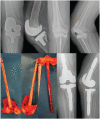Trends in the treatment of infected knee arthroplasty
- PMID: 33204510
- PMCID: PMC7608567
- DOI: 10.1302/2058-5241.5.190069
Trends in the treatment of infected knee arthroplasty
Abstract
Essential treatment methods for infected knee arthroplasty involve DAIR (debridement, antibiotics, and implant retention), and one and two-stage exchange arthroplasty.Aggressive debridement with the removal of all avascular tissues and foreign materials that contain biofilm is mandatory for all surgical treatment modalities.DAIR is a viable option with an acceptable success rate and can be used as a first surgical procedure for patients who have a well-fixed, functioning prosthesis without a sinus tract for acute-early or late-hematogenous acute infections with no more than four weeks (most favourable being < seven days) of symptoms. Surgeons must focus on the isolation of the causative organism with sensitivities to bactericidal treatment as using one-stage exchange.One-stage exchange is indicated when the patients have:minimal bone loss/soft tissue defect allowing primary wound closure,easy to treat micro-organisms,absence of systemic sepsis andabsence of extensive comorbidities.There are no validated serum or synovial biomarkers to determine optimal timing of re-implantation for two-stage exchange.Antibiotic-free waiting intervals and joint aspiration before the second stage are no longer recommended. The decision to perform aspiration should be made based on the index of suspicion for persistent infection.Re-implantation can be performed when the treating medical team feels that the clinical signs of infection are under control and serological tests are trending downwards. Cite this article: EFORT Open Rev 2020;5:672-683. DOI: 10.1302/2058-5241.5.190069.
Keywords: infected total knee arthroplasty; periprosthetic infection; trends.
© 2020 The author(s).
Conflict of interest statement
ICMJE Conflict of interest statement: IRT reports consultancy, payments for lectures including service on speakers’ bureaus, and royalties from Smith & Nephew outside the submitted work. The other authors declare no conflict of interest relevant to this work.
Figures





Similar articles
-
[Treatment of Acute Periprosthetic Infections with DAIR (Debridement, Antibiotics and Implant Retention) - Success Rate and Risk Factors of Failure].Acta Chir Orthop Traumatol Cech. 2019;86(3):181-187. Acta Chir Orthop Traumatol Cech. 2019. PMID: 31333181 Czech.
-
Debridement, antibiotics, and implant retention after revision arthroplasty : antibiotic mismatch, timing, and repeated DAIR associated with poor outcome.Bone Joint J. 2022 Apr;104-B(4):464-471. doi: 10.1302/0301-620X.104B4.BJJ-2021-1264.R1. Bone Joint J. 2022. PMID: 35360944 Review.
-
Irrigation and Debridement, Modular Exchange, and Implant Retention for Acute Periprosthetic Infection After Total Knee Arthroplasty.JBJS Essent Surg Tech. 2019 Nov 1;9(4):e38.1-2. doi: 10.2106/JBJS.ST.19.00019. eCollection 2019 Oct-Dec. JBJS Essent Surg Tech. 2019. PMID: 32051782 Free PMC article.
-
Debridement, antibiotics and implant retention (DAIR) is successful in the management of acutely infected unicompartmental knee arthroplasty: a case series.Ann Med. 2023 Dec;55(1):680-688. doi: 10.1080/07853890.2023.2179105. Ann Med. 2023. PMID: 37074322 Free PMC article.
-
Late Acute Hematogenous Infections after Total Knee Arthroplasty: Results of Debridement, Antibiotics, and Implant Retention.Arch Bone Jt Surg. 2021 May;9(3):249-254. doi: 10.22038/abjs.2020.46942.2293. Arch Bone Jt Surg. 2021. PMID: 34239951 Free PMC article. Review.
Cited by
-
Application of the New Irrigation Protocol to Reduce Recurrence Rate in the Management Of Periprosthetic Joint Infection.Orthop Surg. 2024 Mar;16(3):577-584. doi: 10.1111/os.13948. Epub 2024 Jan 18. Orthop Surg. 2024. PMID: 38238252 Free PMC article.
-
Management strategies for prosthetic joint infection: long-term infection control rates, overall survival rates, functional and quality of life outcomes.EFORT Open Rev. 2021 Sep 14;6(9):727-734. doi: 10.1302/2058-5241.6.210008. eCollection 2021 Sep. EFORT Open Rev. 2021. PMID: 34667643 Free PMC article. Review.
-
An Antibacterial-Loaded PLA 3D-Printed Model for Temporary Prosthesis in Arthroplasty Infections: Evaluation of the Impact of Layer Thickness on the Mechanical Strength of a Construct and Drug Release.Pharmaceutics. 2024 Aug 30;16(9):1151. doi: 10.3390/pharmaceutics16091151. Pharmaceutics. 2024. PMID: 39339188 Free PMC article.
-
Worse outcome of debridement, antibiotics, and implant retention in acute hematogenous infections than in postsurgical infections after total knee arthroplasty: a multicenter study.Knee Surg Relat Res. 2022 Aug 17;34(1):38. doi: 10.1186/s43019-022-00165-z. Knee Surg Relat Res. 2022. PMID: 35978420 Free PMC article.
-
Neglected Posterior Dislocation Septic Loosening and Prolonged Flexion Contracture of Total Knee Arthroplasty: A Case Report.Am J Case Rep. 2021 Oct 14;22:e931857. doi: 10.12659/AJCR.931857. Am J Case Rep. 2021. PMID: 34648481 Free PMC article.
References
-
- Gehrke T, Alijanipour P, Parvizi J. The management of an infected total knee arthroplasty. Bone Joint J 2015;97-B:20–29. - PubMed
-
- Kurtz SM, Lau E, Schmier J, Ong KL, Zhao K, Parvizi J. Infection burden for hip and knee arthroplasty in the United States. J Arthroplasty 2008;23:984–991. - PubMed
-
- Gomez-Urena EO, Tande AJ, Osmon DR, Berbari EF. Diagnosis of prosthetic joint infection: cultures, biomarker and criteria. Infect Dis Clin North Am 2017;31:219–235. - PubMed
Publication types
LinkOut - more resources
Full Text Sources

